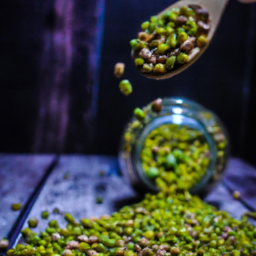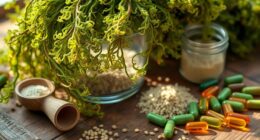Jungle juice is the ultimate party drink, guaranteed to get the festivities started and keep them going all night long. If you’ve been to a college party, backyard BBQ, or summer cookout, chances are you’ve had a taste of jungle juice. Trust me, it’s a wild ride.
Making jungle juice is like creating a science experiment in your own kitchen. It’s a mix of different alcohols, juices, and fruits that come together to create a delicious and potent drink. But don’t be intimidated by the recipe. With a little know-how and a lot of creativity, you can make a batch of jungle juice that will have your guests coming back for more.
So, let’s dive in and learn how to make the perfect jungle juice.
Key Takeaways
- Jungle juice is a punch-style drink made by mixing different alcohols, juices, and fruits, with ingredients varying based on personal preferences and the recipe being followed.
- Properly preparing the fruit and adjusting for alcohol content are essential to infusing the jungle juice with its flavors, and chilling the jungle juice helps to blend the flavors properly and improve the taste.
- Mixing techniques can vary depending on personal preference and the size of the batch, and adding ice to the punch bowl not only keeps it cold but also dilutes the alcohol in the drink.
- When serving and presenting jungle juice, it’s important to set up a serving area with plastic cups, straws, and cocktail stirrers, and to add tropical flowers or fruit slices for decoration, while also encouraging guests to drink responsibly and providing non-alcoholic options and safe transportation home.
Gather Your Ingredients
You’re gonna need to grab all of your ingredients for jungle juice before you start making it. The ingredients can vary based on personal preferences and the recipe you choose to follow. Some common ingredients include fruit juices, soda, vodka, rum, and fruit chunks. If you’re on a tight budget, you can opt for ingredient alternatives such as frozen fruit instead of fresh, or cheaper brands of alcohol. Don’t worry too much about using high-end ingredients as jungle juice is typically a punch-style drink that’s meant to be shared with a large group of people.
Cost saving tips can also be applied when purchasing your ingredients. Buying in bulk is a great way to save money, especially if you’re planning on making a large batch of jungle juice. You can also check for sales or discounts at your local liquor store or supermarket.
Now that you have your ingredients, it’s time to determine your recipe and start mixing!
Determine Your Recipe
To come up with the perfect jungle juice recipe, it’s like creating a unique cocktail that captures the essence of a tropical paradise. Experimenting with flavors is key to achieving this.
You can start with a base of fruit juices like pineapple, orange, and cranberry, and then add in other flavors like coconut or mango. To really make it your own, try adding in a splash of grenadine or some sliced fresh fruit like strawberries or kiwi. Don’t be afraid to get creative and mix and match until you find the perfect combination.
It’s also important to adjust for alcohol content. You want to make sure that your jungle juice is enjoyable, but not too strong. A good rule of thumb is to stick to around 2-3 types of alcohol, and to use more mixer than alcohol.
To adjust for alcohol content, you can add more or less of each type of alcohol, or even switch out one type for another. Keep in mind that some alcohols have higher alcohol percentages than others, so be sure to take that into account when making adjustments.
With these tips, you’ll be well on your way to creating the perfect jungle juice recipe. Now, let’s move on to preparing your fruit.
Prepare Your Fruit
Get ready to add a burst of flavor to your party with some perfectly prepared fruit in your jungle juice recipe. The key to making delicious jungle juice is selecting the right fruits and preparing them correctly.
When it comes to fruit selection, choose fruits that are in season and have a good balance of sweetness and tartness. Some popular options include strawberries, pineapples, oranges, and lemons. You can also add in some berries like blueberries or raspberries for a burst of color and flavor.
Once you’ve selected your fruits, it’s time to prepare them. Start by washing them thoroughly and removing any stems or seeds. Cut larger fruits like pineapples and oranges into smaller pieces, and slice lemons and strawberries. You can also mash up some of the fruits to release their juices.
By preparing your fruits properly, you’ll ensure that they infuse the jungle juice with their flavors and create a delicious and refreshing drink that your guests will love. Now, it’s time to mix your ingredients and take your jungle juice to the next level of flavor.
Mix Your Ingredients
Now that the fruit is prepared, it’s time to mix all the ingredients together to create a delicious and refreshing beverage that will be the hit of your party. Mixing techniques can vary depending on personal preference and the size of your batch. For larger batches, it’s best to mix all the ingredients in a large container or cooler to ensure even distribution of flavors. Some popular mixing techniques include stirring with a large spoon or ladle, shaking in a sealed container, or using a punch dispenser with a spout for easy serving.
When it comes to flavor combinations, the possibilities are endless. A classic combination is mixing fruit juices such as pineapple, orange, and cranberry with rum and vodka. For a sweeter taste, add lemon-lime soda or ginger ale. For a more tropical flavor, add coconut rum and pineapple juice. Don’t be afraid to experiment with different fruits and liquors to find your own unique flavor. Once all the ingredients are mixed together, it’s time to chill your jungle juice to perfection.
Chill Your Jungle Juice
Now that I’ve mixed my jungle juice, it’s time to chill it.
I’ll start by placing my punch bowl in the fridge to ensure it stays cold.
Next, I’ll add ice to the bowl to keep the mixture chilled.
It’s important to let it chill for at least an hour before serving to allow the flavors to meld and the temperature to drop to the desired level.
Place Your Punch Bowl in the Fridge
To keep your jungle juice cool and refreshing, you’ll want to place your punch bowl in the fridge before serving. This step is essential to ensure that your guests enjoy every sip of the punch. Here are a few benefits of chilling your jungle juice and why temperature control is critical in making it:
- Chilling your jungle juice helps to blend the flavors properly and improves the taste.
- It keeps the juice fresh and prevents the growth of bacteria, which can cause food poisoning.
- The cold temperature helps to slow down the oxidation process, which can affect the color and flavor of the juice.
- A chilled punch bowl adds a touch of elegance to your presentation and impresses your guests.
Now that your punch bowl is chilled, the next step is to add ice to keep it cold.
Add Ice to Keep it Cold
You’ll want to keep your guests refreshed and impressed by adding ice to your chilled punch bowl, ensuring that every sip they take is cool and delicious. Adding ice to your jungle juice not only keeps it cold, but it also dilutes the alcohol in the drink, making it easier to drink for those who aren’t used to strong drinks.
When it comes to the type of ice to use, there are a few options. Small ice cubes melt quickly, ensuring that the drink stays cold without diluting it too much. Crushed ice is great for blended drinks or for those who prefer a slushy texture. And if you’re feeling fancy, you can even use decorative ice spheres or cubes to add a touch of elegance to your punch bowl.
Regardless of the type of ice you choose, be sure to add enough to keep the drink cold throughout the party.
To make sure your jungle juice stays cold and delicious, let it chill for at least an hour before serving. This will give the flavors time to meld together and the alcohol time to infuse into the fruit juices.
So, sit back, relax, and let the fridge do the work while you prepare for a night of fun with your friends.
Let it Chill for at Least an Hour
When you’re getting ready for the party, make sure to give your jungle juice enough time to chill in the fridge, so that the flavors can come together and create a totally rad experience for your taste buds.
There are several benefits of chilling your jungle juice, such as enhancing the taste and aroma of the ingredients and making it more refreshing on a hot summer day. Here are some tips on how long you should let your jungle juice chill for optimal results:
- Chill it for at least an hour: This will allow the flavors to meld together and create a well-balanced taste.
- Don’t over-chill it: If you leave it in the fridge for too long, it may lose some of its flavor and become too cold to enjoy.
- Use a thermometer: If you want to be precise, use a thermometer to check the temperature of the jungle juice. It should be around 40°F to 45°F for the best taste.
- Stir it occasionally: To make sure the ingredients are evenly distributed, stir the jungle juice occasionally while it’s chilling in the fridge.
- Cover it with plastic wrap: This will prevent any odors or bacteria from getting into the jungle juice and affecting its taste.
Now that your jungle juice has chilled to perfection, it’s time to serve it up and get the party started!
Serve Your Jungle Juice
Now it’s time to start serving your delicious jungle juice! Before you begin, make sure you have all the necessary party decorations and serving utensils ready. This will not only make your presentation look more impressive, but it will also make serving your guests much easier. You can lay out plastic cups, straws, and cocktail stirrers alongside your jungle juice bowl. To add some festive flair, consider placing some tropical flowers or fruit slices around the table.
Once your serving area is set up, it’s time to pour your jungle juice and let your guests enjoy it. Remember to stir the juice before each pour to ensure that all the flavors are evenly distributed. As your guests enjoy their drinks, be sure to refill the jungle juice bowl as needed. With its fruity and refreshing taste, your guests are sure to keep coming back for more. And when the party’s over, remember to store any leftovers in the refrigerator for later enjoyment.
Store Any Leftovers
After the party, make sure to store any remaining jungle juice in the refrigerator to keep it fresh for future enjoyment. Storing leftovers properly is crucial in preventing spoilage and ensuring that the juice stays safe to drink.
Here are three essential tips to keep in mind:
-
Transfer the jungle juice into a container with a tight-fitting lid. This will prevent air from entering and keep the juice from oxidizing, which can cause it to spoil faster.
-
Label the container with the date you made the jungle juice. This will help you keep track of how long it has been in the fridge and avoid consuming it past its expiration date.
-
Store the container in the back of the refrigerator where it is the coldest. This will help maintain the freshness of the juice and prevent bacteria growth.
Now that you know how to store your leftover jungle juice properly, let’s move on to some tips for making the perfect jungle juice.
Tips for Making the Perfect Jungle Juice
Believe it or not, creating the ultimate jungle juice concoction is a lot like crafting the perfect love potion. You need the right ingredients, the perfect blend, and just the right amount of mixing techniques to make it truly memorable.
When it comes to choosing the best fruits for your jungle juice, it’s important to pick ones that are both flavorful and visually appealing. Some of the best fruits to consider include pineapple, watermelon, strawberries, and oranges. You can also add in some frozen fruit like peaches or mango for an added twist.
When it comes to mixing techniques, there are a few things to keep in mind. First, always add the alcohol last so that it doesn’t overpower the other flavors. You can also add in some fruit juice or soda to help balance out the sweetness. Don’t be afraid to experiment with different ratios until you find the perfect blend.
With these tips in mind, you’ll be well on your way to creating a jungle juice that will have your guests coming back for more. Speaking of which, there are also some fun variations to try that will take your jungle juice game to the next level.
Fun Variations to Try
Get ready to take your party to the next level with these fun twists on your classic jungle juice recipe! One of the easiest ways to add some variety to your jungle juice is by playing with different flavor combinations. For example, you can switch up the fruit juices you use or add in some soda or sparkling water for some fizz. Here are some flavor combinations to try:
| Fruit Juice | Soda | Sparkling Water |
|---|---|---|
| Orange | Sprite | Lemon |
| Pineapple | Ginger Ale | Lime |
| Grapefruit | Mountain Dew | Grape |
Another way to make your jungle juice stand out is by getting creative with your serving suggestions. Instead of just serving it in a regular punch bowl, try serving it in a hollowed-out watermelon or pineapple. You can also add some fun garnishes like fruit skewers or a rim of sugar or salt on the glass. With these fun variations, your guests will be impressed and begging for the recipe.
Enjoy responsibly by making sure to provide non-alcoholic options and encouraging guests to drink responsibly.
Enjoy Responsibly
When hosting a party with jungle juice, it’s important to remember to encourage guests to drink responsibly. This means setting limits and reminding them to pace themselves.
Additionally, providing non-alcoholic options like water or soda can help to prevent over-consumption.
Lastly, it’s crucial to have a plan for safe transportation home, whether it’s designated drivers, ride-sharing apps, or simply encouraging guests to stay over if they’re unable to drive.
As the host, it’s our responsibility to ensure the safety and well-being of our guests.
Encourage Guests to Drink Responsibly
Hey guys, let’s all remember to pace ourselves and make sure we’re drinking responsibly while enjoying this delicious jungle juice. It’s important to have a designated driver or plan for a safe way to get home before you start drinking. We want everyone to have a good time, but alcohol education and awareness are critical in preventing accidents and injuries.
To help encourage responsible drinking, I’ve created a table of tips and tricks to keep in mind. These are simple suggestions that can make a big difference in how we approach alcohol at this gathering. Let’s all be proactive in taking care of ourselves and each other.
| Tips for Responsible Drinking |
|---|
| Drink water in between alcoholic beverages |
| Eat food throughout the evening |
| Limit the amount of alcohol consumed |
| Designate a sober driver or use a rideshare service |
| Be aware of your own limits and stop drinking if necessary |
As we enjoy the jungle juice, let’s also remember to offer non-alcoholic options for those who choose not to drink. It’s important to make everyone feel included and comfortable, regardless of their personal choices.
Provide Non-Alcoholic Options
Now that we’ve talked about the importance of encouraging guests to drink responsibly, let’s discuss another way to ensure their safety at your party: providing non-alcoholic options.
As a responsible host, it’s important to recognize that not everyone drinks or wants to drink alcohol, and it’s important to provide mocktail options and alternative mixers to accommodate them.
Here are a few ideas to get you started:
- Sparkling water with a splash of fruit juice and a garnish of fresh herbs
- Virgin versions of popular cocktails, like a virgin margarita or a virgin mojito
- A variety of sodas and juices for guests to mix and match
- A fun and fruity punch that can be enjoyed with or without alcohol
By offering a range of non-alcoholic options, you not only make your guests feel welcome and included, but you also help to prevent overconsumption of alcohol.
Remember, safety should always be a top priority when hosting a party.
And speaking of safety, the next step in ensuring a responsible and enjoyable party is to have a plan for safe transportation home.
Have a Plan for Safe Transportation Home
To ensure the safety of your guests after the party, it’s important to plan ahead and arrange for safe transportation home. One option is to hire a designated driver who can stay sober throughout the night and ensure that everyone gets home safely. This person should not drink any alcohol and should be responsible for driving guests home or calling a taxi or ride-sharing service if necessary.
Another option is to use a ride-sharing service like Uber or Lyft. These services are convenient and affordable, and they can help ensure that your guests get home safely. Before the party, you can set up an account with one or both of these services, and then make sure that your guests are aware of the options available to them. You can also provide them with a list of local taxi companies or public transportation options, so that they can make an informed decision about how to get home. By planning ahead and taking these steps, you can help ensure that everyone has a safe and enjoyable time at your party.
| Pros | Cons | Tips | ||
|---|---|---|---|---|
| Designated Driver | No cost | Can be difficult to find someone willing to be the designated driver | ||
| Choose someone who is responsible and trustworthy | ||||
| Uber/Lyft | Convenient and affordable | May not be available in all areas or at all times | ||
| Set up an account ahead of time and provide guests with the information they need | ||||
| Taxi/Public Transportation | Widely available | Can be more expensive than other options | ||
| Provide guests with a list of local companies and schedules | Consider offering a shuttle service or arranging group transportation for events or activities |
Frequently Asked Questions
What are some common mistakes to avoid when making jungle juice?
To avoid common mistakes when making jungle juice, I recommend using fresh ingredients, measuring alcohol carefully, and avoiding too much sugar. These tips and tricks will ensure a balanced and delicious drink for your guests.
Can you make jungle juice without alcohol?
Yes, you can make non-alcoholic jungle juice variations by using fruit juices, soda, and fresh fruits. For a kid-friendly version, avoid using alcohol and add more sweeteners. Remember to keep it colorful and refreshing!
How long does jungle juice last in the fridge?
Jungle juice can last up to 3 days in the fridge when stored properly in an airtight container. It’s important to keep it chilled and avoid leaving it at room temperature for too long to ensure its shelf life.
How do you adjust the recipe for a larger or smaller crowd?
Adjusting the recipe for a larger or smaller crowd is like conducting an orchestra. Start with the base ingredients, adjust the ratios accordingly, taste test, and repeat until it’s perfect. Serving size is just a matter of math.
What are some alternative fruits or juices that can be used in jungle juice?
When it comes to alternative fruits for Jungle Juice, pineapple and watermelon work best. But for a unique twist, try exploring exotic juices like guava or passionfruit. Experiment to find your perfect blend.
Conclusion
Well, that’s it! You now know how to make jungle juice like a pro. It may seem like a daunting task, but with the right ingredients and recipe, you can create a delicious and refreshing drink that will impress your guests. Just remember to always enjoy responsibly and never drink and drive.
Now, some of you may be thinking, "But isn’t jungle juice just a college party drink?"While it may have originated as a staple at college parties, jungle juice has evolved into a versatile drink that can be enjoyed by anyone at any occasion.
Whether you’re hosting a backyard BBQ or a fancy dinner party, jungle juice can be customized to fit any theme or taste preference. So go ahead and give it a try! Experiment with different fruits and liquors to create your own unique twist on this classic drink.
And don’t forget to share your creations with others. Jungle juice is meant to be enjoyed with friends and family. Cheers!
Aurelia is the Editor-in-Chief of The Graceful Kitchen, a vegan lifestyle blog that focuses on delicious, nutritious, and ethical eating. A lifelong vegan, Aurelia is passionate about sharing her love of plant-based cuisine with others. She is a regular contributor to several online and print publications, and has been interviewed by major news outlets about the benefits of a vegan diet. In her free time, Aurelia enjoys cooking, hiking, and spending time with her cats.








